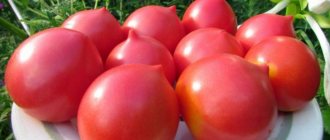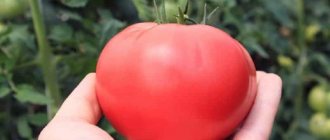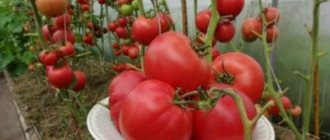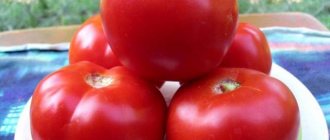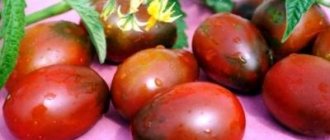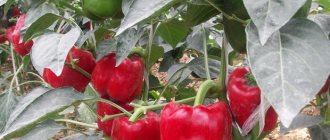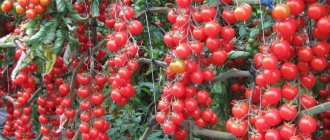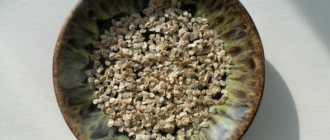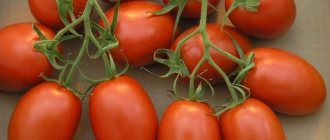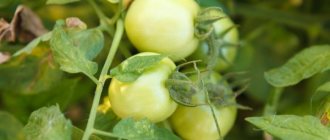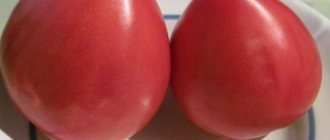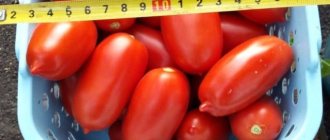Author's rating
Author of the article
Yakov Pavlovich
Professor, Head of the Department of Vegetable Growing
Articles written
153
The Red Riding Hood tomato variety, widespread in all latitudes and regions, has gained such popularity for good reason. Another name for the variety is “Rotkäppchen”. Early ripening tomatoes, with proper care, produce a stable harvest, which is one of the first to appear on the gardener’s table. The universal variety is planted in greenhouses, small greenhouses and open ground. Growing Little Red Riding Hood has its own characteristics, which are worth familiarizing yourself with in more detail.
Tomato Red Riding Hood: variety description
The tomato variety Red Riding Hood in German sounds like Rotkäppchen, which translates as Little Red Riding Hood. It was developed in Germany a long time ago. The Red Riding Hood tomato variety was brought to Russia in 2010; Red Riding Hood was added to the State Register in 2011; it can be planted in absolutely any area of the country.
Tomatoes of the Red Riding Hood variety are considered standard, and they also have a growth limit. Those gardeners who do not have extra time to care for vegetables can rejoice most of all, since they do not need to be cut, pinched and tied up. But some summer residents still recommend tying up the bushes, since at the moment of fruiting the bushes are completely covered with tomatoes, and due to the weight, the bush bends to the ground.
The shrub grows 30 cm in height, which is very convenient. They can be tied to the middle part of the bush, and that’s all, this will be enough for stable support, and the bush will also look beautiful and aesthetically pleasing.
Red Riding Hood tomatoes: photo of variety
Despite its small dimensions, the trunk of the bush is very strong and there are few foliage. Most gardeners plant the plant in open beds, but the variety can also be planted in a greenhouse or a film tunnel in the spring. The first harvest after greenhouse conditions can be harvested in the last month of spring. Also, Red Riding Hood tomatoes can be placed on a windowsill or insulated balcony; the most important thing is that the plant receives enough light, and harvesting will not take long. It is planted indoors in March or October.
Important: If the gardener does not have a growing area for tomatoes, then they can be planted to grow on a windowsill or balcony.
The Red Riding Hood tomato variety is classified not as early ripening, but as ultra-early ripening. From the formation of sprouts to the moment of harvesting, the harvest takes less than 3 months. If the variety grew in harsh weather conditions, then the tomatoes can be harvested at the end of July. And on the 15th day of the last summer month, the fruits are collected and various culinary manipulations are done with them.
For Red Riding Hood tomatoes, the yield indicators are very high, and such are rarely found in early-ripening varieties. One bush with proper care can produce up to 1 kg of tomatoes. Approximately 2.5 kg of fruit is obtained per 1 m2.
Important: To get the maximum yield, you need to shake the flowering brushes during the flowering period so that they are better pollinated.
Red Riding Hood tomatoes have good immunity, which can resist various tomato diseases: Tomato mosaic, fusarium, verticellosis. Also, the plant is not susceptible to late blight, since the crop is harvested before the onset of this disease, which occurs in August.
The Red Riding Hood tomato variety can easily cope for a long time without moisture; it will also not be critical if the plant does not receive additional light and heat.
Red Riding Hood tomatoes: photo of variety
Plant care rules
Mulching the soil and watering is the key to successful cultivation of the variety. Even a beginner can handle this variety. Cut grass or straw is used as mulch here.
Expert opinion
Stanislav Pavlovich
Gardener with 17 years of experience and our expert
Ask a Question
Advice! The culture is fed with urea, boric acid or potassium monophosphate 7 days after planting in a permanent place. Plants must come to life on their own and adapt to new conditions.
There is no need to form such a tomato bush in the future. Low stems themselves will turn the leaves in the most convenient direction.
Picking
Little Red Riding Hood is picked only at the seedling stage. There is also no need to cut off the tops. The effectiveness of this method in relation to the variety has not been fully proven.
Watering
Watering of plants is carried out using the root method. As tomatoes begin to bloom, they need to be watered less frequently. Another way to deliver nutrients to the roots is by loosening. The soil under the Red Riding Hood variety is loosened carefully and superficially so as not to damage the roots of the crop.
Top dressing
Before flowering, tomato seedlings are fed with humus or special fertilizers. “Compost tea”, which is made from humus and grass clippings, is also suitable. The compost is filled with water in a barrel, grass is added, and left to ferment for a week under a film.
Hardening
Tomatoes receive their first hardening at the seedling stage. In other cases, the tomatoes are simply not wrapped until fruit sets in a permanent place, unless severe frosts are expected.
Characteristics of the Red Riding Hood tomato
The Red Riding Hood tomato variety got its name not because of the coloring of the tomatoes, but because of its growth characteristics. Tomatoes usually grow in the center or at the top of the bush, as if forming a red cap of tomatoes.
The fruits of Red Riding Hood tomatoes have the following features:
- Tomatoes have a round shape;
- If the fruit is unripe, it has a greenish color with a spot at the base. When the fruits ripen, they acquire a bright red color, and the stain disappears on its own;
- Tomatoes weigh about 40-50 g and are small in size;
- Inside the fruit there are no more than 2 chambers with seeds;
- There are 4 fruits on one hand;
- The peel is thin and tender. The flesh is fleshy, the taste is amazing, they are ideally combined in salad dishes. When ripened, the tomatoes do not crack; they can be easily rolled whole into jars;
- They have a pleasant aroma and interesting taste;
- It is not worth transporting fruits for a long time; tomatoes are poorly stored.
We grow tomatoes in an open garden and in a greenhouse
Tomatoes of this variety are not picky. In greenhouse conditions and in open ground they require almost identical care. There are several nuances that are worth paying attention to.
Depending on the further “habitat” of the bush, planting times differ. The seedlings are transplanted into the greenhouse starting in mid-May, and into an open garden bed at the beginning of June.
In the garden, Red Riding Hood tomatoes are best placed close to the following crops: parsley, zucchini, cauliflower, dill, cucumbers or carrots. This kind of neighborhood would be ideal. It is important not to plant these tomatoes where potatoes, eggplants or sweet peppers previously grew.
It should be noted that pests threaten plants in a greenhouse more often.
Another fact about these tomatoes will please gardeners: the plant is suitable for planting not only in greenhouses, but also at home on a balcony or windowsill. Thanks to its compactness and unpretentiousness, the bush grows and bears fruit even in unfavorable conditions.
Growing tomatoes Little Red Riding Hood
Since Red Riding Hood tomatoes are classified as early ripening, in the southern regions the seeds can be planted immediately in open soil, or if there is a need, the crops should be covered with film. If you plan to develop a variety in the central and northern regions, then the variety is propagated using seedling material.
To find out how many seeds purchased in the store will sprout, you need to immerse them in water, which must be salted in advance. The seed that floated up is unusable and can be thrown away, and those Red Riding Hood tomato seeds that sank down are washed in water to remove salt, and then Red Riding Hood tomato seeds are planted in the prepared container. If the room temperature is more than 18 degrees, then shoots appear after a week, maybe a little less. In the initial period after germination, the temperature in the room is lowered by 5 ̊ C, or it is necessary that the daytime temperature differs from the nighttime one. This procedure will strengthen the roots and further harden the plant. After the leaves appear, the tomatoes are dived into separate containers. Before transplanting, you need to fertilize the plant about 2 times, and you also need to ensure sufficient heat and light.
Tomato Red Riding Hood: photo of variety
Important: Shrubs can be planted close to each other, as they are small in size. You can fit no more than 5 Red Riding Hood tomatoes per 1 m2.
The first inflorescence appears in the region of 5-6 leaves. To protect the plant from diseases during such a major and difficult period as flowering, tomatoes need to be sprayed with iodine and boric acid. This measure increases the pollination of the plant. The Red Riding Hood variety has a fairly strong and strong immune system, which is capable of fighting various tomato diseases without difficulty, so there is no need to additionally treat the plant with specialized substances.
Red Riding Hood tomatoes grow in families and gradually.
The nuances of growing a variety
Due to early ripeness in the south, the seeds are sown directly into the ground or under a film cover. In the north they use seedlings. Little Red Riding Hood seedlings can be planted in greenhouses as early as March. This variety is cold-resistant, but it is protected from frost in the same way as standard tomato varieties.
Seed preparation
In a saline solution, all seeds from the bag are checked for germination. Soak them in water with salt for a couple of minutes. Pacifiers float to the surface. They are removed along with water.
Then the seeds are washed, sometimes soaked for a day in an activator, then placed in containers for seedlings. There is no need to freeze the seeds to increase the immunity of the crop; they already tolerate cold weather well.
Selecting container and soil
It is most convenient to grow strong tomato bushes in separate pots. The germination rate of the variety is high. You can fill the cups with soil, then deepen the seeds there.
Expert opinion
Stanislav Pavlovich
Gardener with 17 years of experience and our expert
Ask a Question
Humus is suitable for this variety. Ready-made soil mixtures will also not harm the seedlings. And simple soil from the garden will also work.
Let's move on to sowing
If there are no cups available yet, you can place the sprouts or seeds in a single container and then pick them up. A week after planting, I provide the plants with a large difference in night and day temperatures. Sometimes they take it out onto the veranda if the temperature there does not drop below 5 degrees Celsius.
Hardening well strengthens the root system of the variety. Picking Little Red Riding Hood is carried out after the appearance of true leaves on the stem. When planting, the seeds are buried by about 1 cm, watered pointwise, and covered with film for the first days.
Seedling care
After the first week, tomato sprouts are fed for the first time. Before planting in the ground, another fertilizing is carried out. They take care of Little Red Riding Hood according to the standard scheme. Water moderately and add light regularly.
Transplantation to a permanent place
Low-growing and stable tomato bushes are planted at the rate of 5 plants per square meter. The rows should be tight. Stretched plants are tied up immediately. The rest are supported after the fruits ripen if the tomato branches bend to the ground under their weight.
See also Moskvich tomatoes: yield and variety description
Tomato Little Red Riding Hood: reviews from gardeners
Gardeners love the Red Riding Hood tomato variety; some prefer to grow it because of its wide range of positive qualities, but not everyone shares this opinion; there are dissatisfied summer residents who do not like the variety because of its small size.
In my region, not all tomato varieties are able to germinate. Having learned about the Red Riding Hood tomato variety, I immediately went shopping to look for my magic wand and planted Red Riding Hood tomato seeds in the spring. The Red Riding Hood tomato seedlings grew vigorously, despite their miniature size. In early June, I transported tomatoes to the garden. During this period, the nights were cold, so the poet had to cover the tomatoes with a film tunnel, this was a very convenient option, since the bushes are small. The shelter was not removed until the end of the month. After the weather conditions returned to normal, I removed the shelter, but did not throw it very far, since the weather can be changeable. There were a lot of fruits on the bushes; they had already begun to fall to the ground, but I quickly tied them to a support. Tomatoes of the Red Riding Hood variety began to ripen on the 15th of July; in the first days of August, I did not know what to do with my harvest. I am going to plant this variety next year, as the tomatoes have won me over with their taste and abundance of harvest.
I have a summer cottage, and I don’t always have time to arrive on time to tend to the gardens. I decided to choose the Red Riding Hood tomato variety, which did not require very complicated care methods. I planted the seedlings in early March and transplanted them into separate containers in May. I applied fertilizer when the plant began to bloom. The shrubs turned out to be small and looked very compact and beautiful in appearance. Red Riding Hood tomatoes are bright red, medium-sized. I recommended the variety to my neighbors, and they are already excited to plant it on their property next year.
Red Riding Hood tomatoes: photo of variety
Pros and cons of tomatoes
The advantages of Rotkäppchen include the following:
- increased resistance to diseases;
- good yield;
- early ripeness;
- standard agricultural technology;
- high taste qualities;
- compactness;
- lack of picking.
Expert opinion
Stanislav Pavlovich
Gardener with 17 years of experience and our expert
Ask a Question
The disadvantages include soft skin. Its cracking can be avoided if you water the tomatoes strictly according to the schedule in accordance with weather conditions.
Features of cultivation, planting and care
We recommend sowing the seeds of this tomato variety for seedlings 55-60 days before the intended planting in the ground. Seedlings dive at the stage of appearance of the second true leaf.
When planting seedlings in the ground, it is recommended to place up to 8 plants per 1 square meter of land. Planting pattern 70 x 30-40 cm.
Further care for tomatoes consists of timely watering, fertilizing with complex mineral fertilizer on the leaves or at the root, removing weeds and preventive measures to protect the crop from diseases and pests.
You can see other interesting varieties and hybrids of tomatoes with photos, descriptions and reviews in our Tomato Catalog. Enjoy watching.
